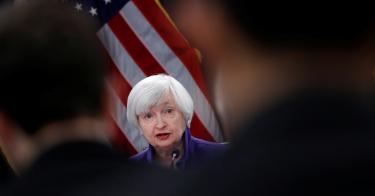Now that Janet Yellen’s term as Fed Chair has ended, retrospective columns are popping up everywhere to define her legacy at the central bank. Last week George Selgin flagged a very good one by Stephen Williamson, titled “Janet Yellen: Performance Review.”
But, as most of the articles concede, it really is too early to define her reign at the Fed.
Still, it is very hard to shake the feeling that Yellen’s tenure falls largely in the “no surprises” category. An academic economist-turned public servant, she broadly fits the mold of most economists nominated to the Board of Governors during the last few decades: a smart person who won’t shake things up too much.
As these appointments go, she was dealt a pretty lousy hand coming into the Chairmanship. So it would make perfect sense if she wanted to ride off into the sunset now that an economic recovery seems to be taking hold. Inflation and unemployment are both low, and GDP growth seems to be inching back up toward 3 percent.
But how much credit should anyone at the Federal Reserve get for these recent improvements?
The low unemployment rate masks some structural changes that even Yellen herself acknowledges are beyond the Fed’s control.
And the labor force participation rate has basically been declining since 2000, when it peaked at 67.3 percent. The rate currently stands at 62.7—the lowest since 1977. Since the series began in 1948, there has been no comparable long-term drop.
Yellen was on the Board of Governors from 1994 to 1997, when she left to chair the Council of Economic Advisers for two years. From 2004 to 2010, she led the San Francisco Fed, then served as the vice chair of the Board from 2010 to 2014. She started her term as Fed Chair in 2014.
It would be silly to blame Yellen for this sustained drop in labor force participation, and comparable logic applies to inflation.
Using the Fed’s current favored measure, the core PCE, inflation has been below 2.5 percent since 1994. In the 1950s, there was a similar 10-year stretch, and the PCE data alone would not have predicted the dramatic increase in inflation that followed in the 1960s and 1970s.
Over time, the processes that generate inflation and unemployment rates are at least as important as the rates themselves, and they tend to change in ways that are difficult to understand. A dose of humility would serve the public better than a rush to base any Fed Chair’s legacy on either of these two time series.
Moreover, focusing only on the “low” inflation values completely ignores how well the Fed is hitting its target and whether the Fed has lost its ability to do so. With regard to Yellen’s legacy, these issues also have to be evaluated in the context of the lousy hand that she was dealt.
By the time she became Fed Chair, she had no choice but to stick with, at least for some time, a completely new and untried operating framework.
The Fed’s open market operations, those that had served as the Fed’s main monetary policy tool for decades, were off the table. Thanks to the Fed’s decision to create a (leaky) floor system, with an above-market rate of interest on excess reserves, the federal funds market had all but collapsed in 2008.
This change is no small matter. Since the crisis, the Fed has been operating chiefly by paying banks to sit on piles of excess reserves. The federal funds targeting which, supposedly, was so vital for “setting” interest rates, has been virtually meaningless.
It’s surprising how few have raised a fuss over this change. For more than two decades the Fed conducted monetary policy by fostering borrowing and lending in the federal funds market, where private banks borrowed and lent to meet their reserve needs. That market activity has not existed since the 2008 crash.
As if that change were not enough of a shock, the Fed’s new system is pretty much an outlier. As best as I can tell, no other major central bank is operating such a system, where it holds its policy rate above most short-term market rates. (This paper is a little dated, but it gives a good description of how major foreign central banks have been operating).
Maybe everything will eventually work out just fine, but the Fed is playing with fire. If rates rise (even back to long-term averages) before the Fed mops up these excess reserves – at its current wind down pace, in two years the Fed’s balance sheet will still be three times its pre-crisis size – the sitting Fed Chair will have his or her hands full.
At that point, the Fed will have to weigh paying billions of dollars in interest to large banks to sit on excess reserves versus watching banks invest those funds in the market. Investing too much of those reserves too quickly is, of course, exactly what the previous two Fed chairs were so worried about. It’s why the Fed has the operating system it currently has.
At worse, Janet Yellen can be faulted for not fixing this situation quickly enough. But it is impossible to make that judgment right now.
This piece originally appeared in Forbes https://www.forbes.com/sites/norbertmichel/2018/02/07/yellens-term-will-remain-undefined-until-the-new-framework-holds-up-or-blows-up/3/#3c4b2baa3eda



